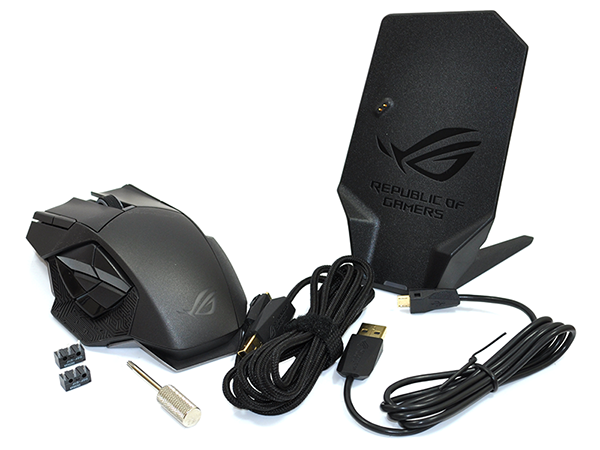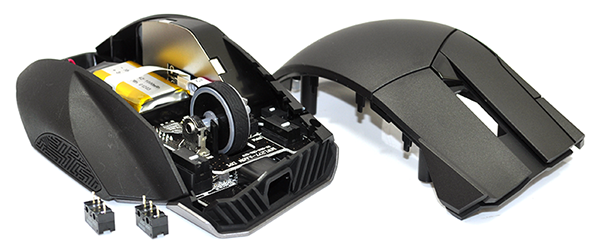Features Explored
Being able to incorporate so many angles without leaving any sharp edges would take some doing, and it turns out Asus has missed a bit. The tips of the left and right clickers are annoyingly sharp in the void in front of the scroll wheel, and they really should be rounded/angled off for comfort.
As is the case with almost every high-end gaming peripheral, there are plenty of RGB LEDs tucked inside Spatha's shell. The scroll wheel, eye-formation buttons and rear ROG logo are all backlit in independently controllable zones, and there are plenty of effects to choose from. The only snag is the LED fitted behind the sensitivity toggle button as it's fixed to white and can't be incorporated into your preferred colour scheme.
On the hardware front, Asus is using tried-and-trusted Omron switches for its primary buttons, and the mouse is driven by an 8,200dpi laser sensor and a 2,000Hz polling rate when used in wired mode. What makes Spatha particularly versatile is that it can be used as a wired or wireless solution, and that's where some of the bundled items come into play.
Wired or Wireless
Included as standard is a wireless receiver/charging dock, a two-metre braided USB cable, a one-metre standard USB cable, a small screw driver, a couple of spare Omron switches and a few ROG stickers (not pictured). Should you choose to keep things simple, you can attach the braided cable to the front of the mouse, plug it in to your PC and use the device as a regular plug-and-play solution.
But that would be doing a disservice to the rather useful charging dock. Made of metal and shipped with an attachable stand, the dock connects to the PC via USB and pairs to the mouse via a 2.4G wireless connection for cable-free pointing. When you're done, stow the mouse on the stand and it'll charge the internal battery, or plug in the braided cable and charge as you go.
You do inevitably lose a bit of performance in wireless mode - polling rate is effectively cut in half - yet it's a handy option to have and the two-in-one implementation works quite well. Even something as simple as docking the mouse is surprisingly satisfying, as Asus uses magnets to keep Spatha in place, and there's just enough weight to the stand to prevent it lifting off as you pull the mouse away.
Customisation Opportunities
Offering a choice of wired or wireless modes is a neat trick, and Asus has another value-add up its sleeves in the form of interchangeable Omron switches. Undoing four screws on Spatha's underside using the supplied screwdriver allows for the top shell to be removed, providing easy access to the default switches. A pair of D2F-01F alternatives are provided, and these increase the operation force from 60g to 75g, should you prefer.
What's inadvertently handy is that the top shell is now open to customisation. It could quite easily be skinned in clan colours, and we wonder if Asus will make a 3D printing template available as an added incentive.
Spatha's hardware has promise, however there is a minor snag when it comes to charging. The dock is powered exclusively via USB and needs to be connected via a PC to function, meaning you'll need to keep your PC turned on at the mains for the battery to charge. Users with a new-ish motherboared featuring 'sleep' charging won't see this as a problem, but if like me you choose to turn your system off completely at the wall, you might have preferred a separate power adapter to keep the mouse charging independently of the PC.













